Welcome to the Jungle
We had a 10 day gap between our House/Dog Sit assignment in KL. We so thought that we would grab the opportunity for a trip over to the jungle in Northern Sumatra. After all, it is only a 1 hour flight to get there.
My cousin Carly has been living in Tangkahan, North Sumatra for over a year now. We were intrigued about her life and surroundings. We wanted to see where she lived and a little about her world.
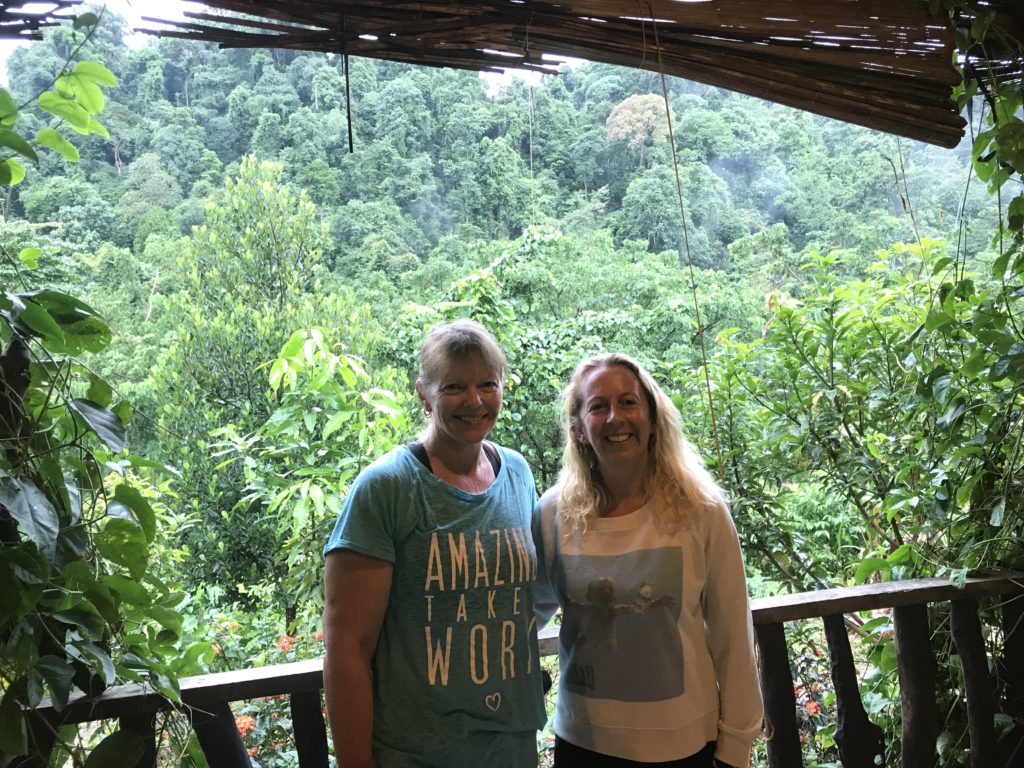
Me and cousin Carly
Carly is a trained vet nurse and zoo keeper – spending a considerable amount of time at the Auckland Zoo. She has gone from living in the metropolis of Auckland to being surrounded in rainforest, working with and educating locals. Whether it’s travelling to local villages to help with Neutering Clinics for dogs or helping to train the elephant mahouts on communicating with tourists – it’s a far cry from her previous life for sure.
Where is Tangkahan?
That is exactly what we wanted to know. Where on earth is Tangkahan?
Although the plane flight is only 1 hour from KL to the capital of Medan, it is another story getting to Tangkahan. On the map it doesn’t really look that far. Our research showed it was going to take us close on 5 hours to get there by car.
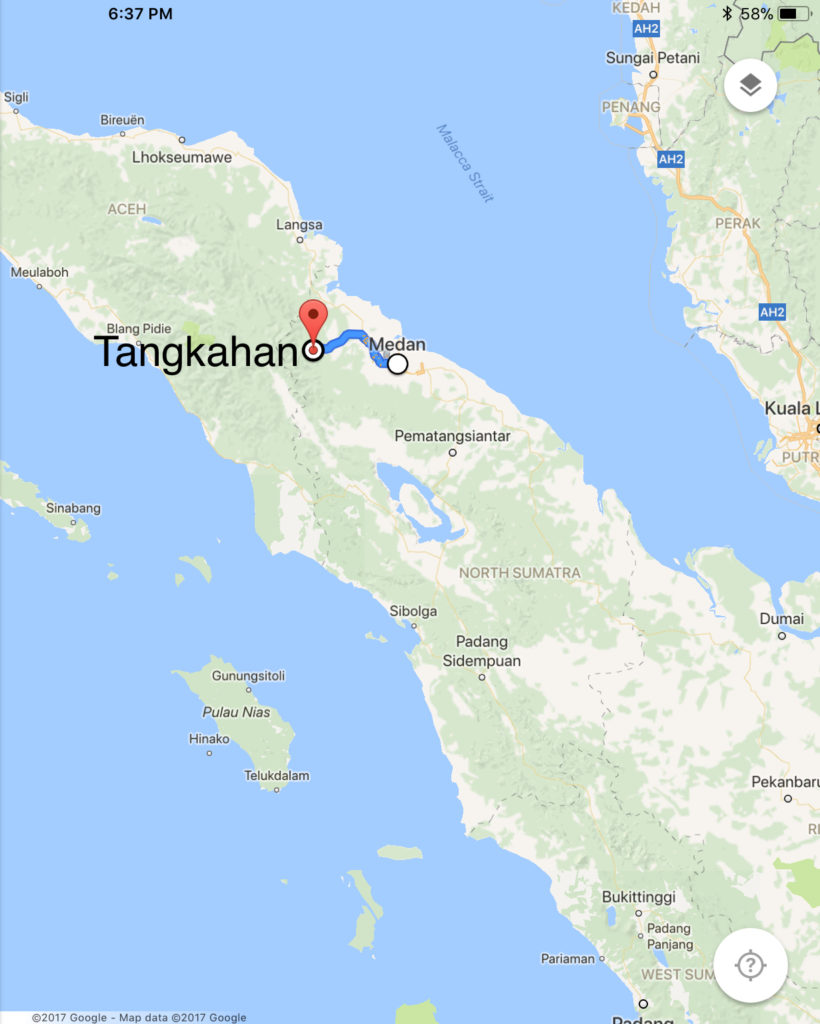
The map shows that it is only 129km but don’t be deceived.
How To Get There
We were reluctant to stay a night in Medan as we hadn’t really read anything positive about the populated city. Because of this, and our flight not arriving until late afternoon, we decided to arrange with Tangkahan Inn to have a driver meet us at the airport for the trip straight through to them. This saved us one night’s accommodation in Medan. Plus saved the cost of getting from the airport to our accommodation then trying to negotiate the local buses the next morning.
The private car pick up cost us 700,000IDR ($72nz) and we decided that it was definitely worth it.
Our pick up at the airport all went smoothly and we were soon on our way.
The Road to Tangkahan
It became very clear as to why the trip was going to take 5 hours. Medan is a huge city and very heavily congested. It is the 3rd largest city in Indonesia with a population of over 2 million people.
Time ticked by as we negotiated our way through bustling streets and the paved footpaths and modern bridges soon morphed into narrower lanes, muddy sidewalks and locals selling their wares and food.
It seemed to take forever to eventually leave the city behind. There were then many rural villages to travel through. There are also the millions of acres of palm trees. These are cultivated for the lucrative but destructive palm oil industry. This palm oil industry has made Medan very wealthy, especially for a just a few. The wealth has not filtered down to the locals as many just survive day to day.
The roads at this stage weren’t too bad, we had been on a lot worse. However, as night descended we soon realised that the further on we got the worse the roads got. By the time it was completely dark we were bumping along and negotiating huge ruts and potholes – not to mention deep slippery clay bog holes. We were only in a 7 seater sedan and I was thinking how much more appropriate a 4×4 vehicle would be right now.
The road sees a high usage from the trucks that carry the palm oil kernels to the plants for processing. This has added to the destruction of the roading network. Little or no money is spent on its upkeep.
Tangkahan Inn
We arrived at Tangkahan Inn pretty much on the 5 hour mark – just in time for some dinner.
It has a very relaxed vibe to it and yes, we were surrounded by jungle.
There is a communal dining/meeting area which is clearly the hub of the establishment. In close surrounds there are separate little cottages dotted around the property.
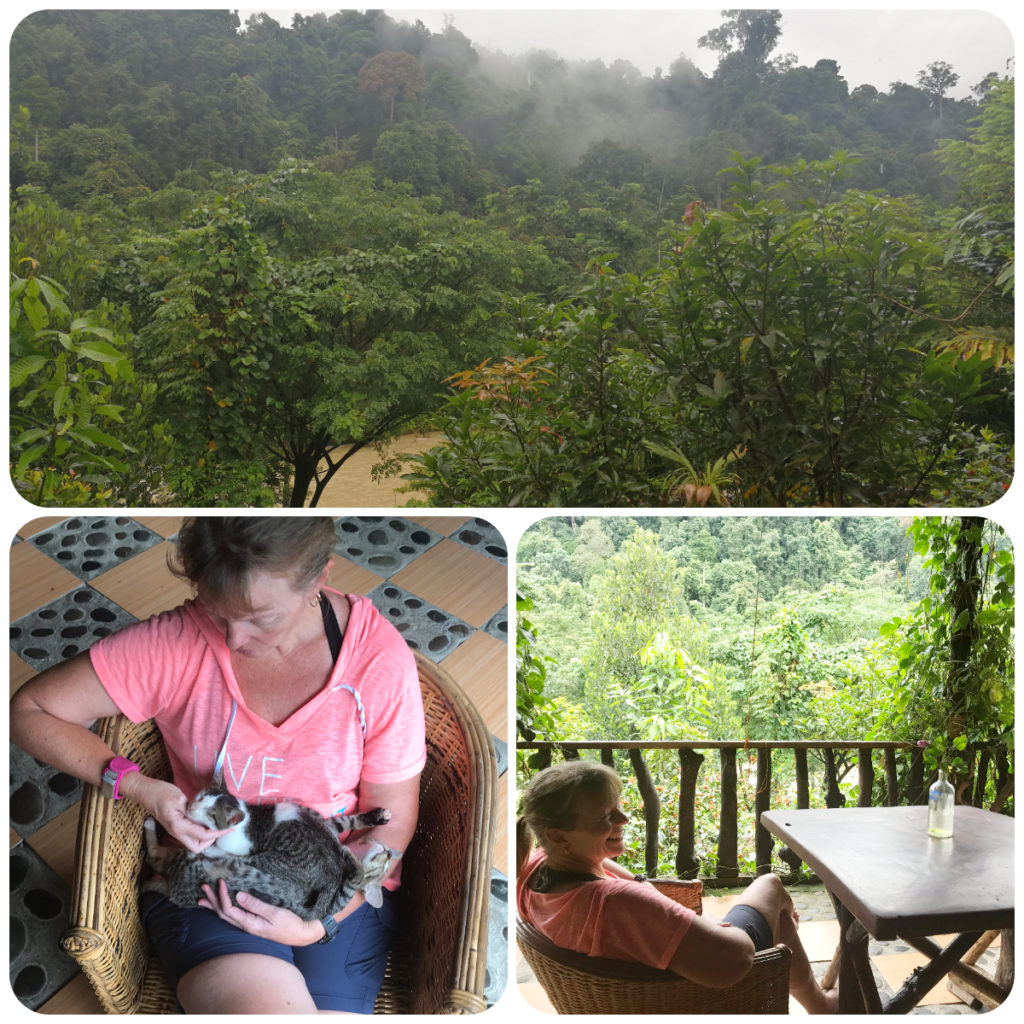
The view from the dining area and getting to know the friendly local kittens.
Our room was connected to Carly’s and overlooked the river and adjacent hills, covered with natural rainforest.
If you are the resort style traveller, then this is probably not the accommodation you would want to be staying in.
Of course there is no A/C and no hot water which is what is to be expected. However, you need to be prepared for no flushing toilet either. Our shower wasn’t working so we needed to use the bucket and water from the vessel beside the toilet (used for flushing).
A cold water shower in the morning from the bucket, washing only the necessities is very ‘character building’.
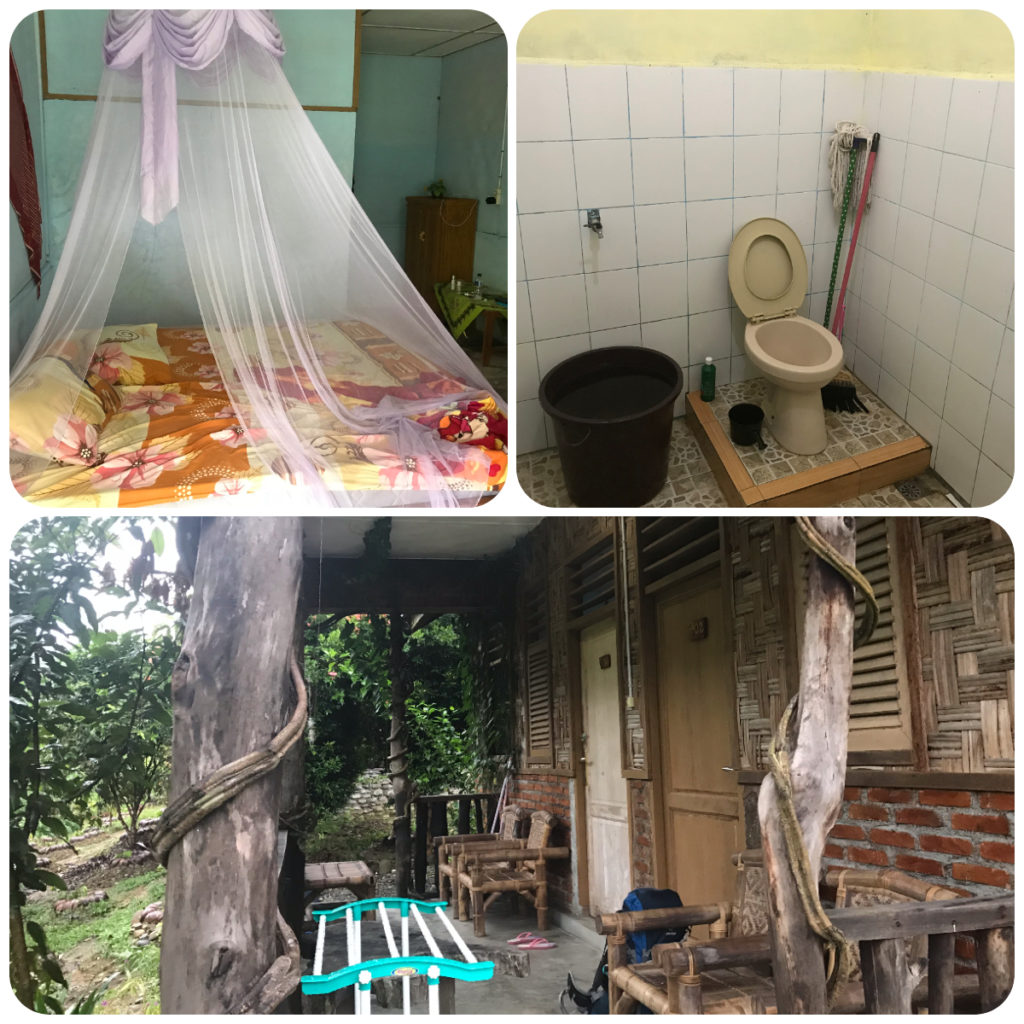
Fear Factor
Nearly everyone has their own level of ‘fear factor’ going on and mine are spiders, crawlies and heights. The first two fears are probably not the best ones to have when staying in the jungle. I used the ‘denial technique’ where if I didn’t look then they weren’t there.
This doesn’t work so well when you are woken at 4am in the morning with Scotty having some sort of epileptic fit (well it seemed like it) beside you, as he jumped out of bed. THERE WAS SOMETHING CRAWLING OVER HIM!!!
Well I went into my own version of a woman possessed – unfortunately I had tucked in the mosquito net so tightly on my side that I couldn’t extricate myself quick enough. I must have looked like a fly caught in a spider web – arms and leg flailing in all directions.
The culprit was located and duly squashed under the mat. It appeared to be some sort of long black bug – identification unknown! Just like the large and colourfully stripped spider which had made its home outside our window.
Activities
Tangkahan Inn can arrange all the activities to do in the area. There are a variety of hiking options of varying distances and duration through the amazing rainforest, River Tubing which includes waterfalls and of course interacting with the elephants.
The Village
This tiny, remote village was practically built on the logging trade in the 1980s and 1990s. Because the people became aware of the damages by such activity they collectively decided to stop illegal logging and transform the area into an functional, self-sustained ecotourism destination.
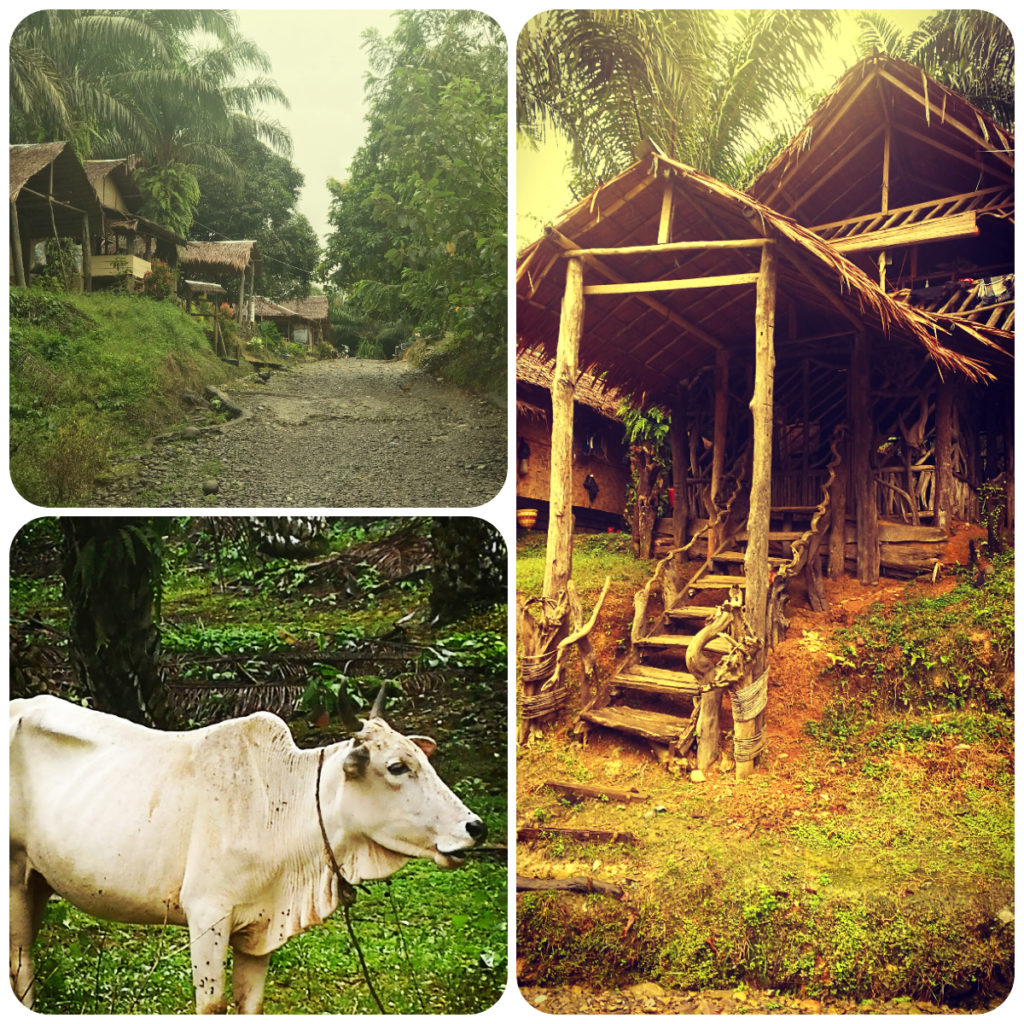
Village scenes
It’s about as remote as you can get and I think because of this, we spent some time just wandering around the village, witnessing their daily lives and activities.
Everyone we came across all had a smile on their face and we were constantly greeted by a wave and a cheerful hello. Of all their trials and tribulations of just surviving day to day, this was not evident on their faces. They appear to be happy with their lot and although many of them still exist with dirt floors, they do not seem to want for much.
Elephants
Many of you who know us will know about our stance on the exploitation of elephants around the world, in particular SE Asia. Many tourist attractions still offer riding and chaining up of the elephants and cruel treatment in order to break their spirit and make them tourist friendly.
The Conservation Response Unit (CRU) was formed to stop the exploitation of the surrounding rainforest – a team of 10 rescued and rehabilitated Sumatran elephants and their mahouts help safeguard the national park to protect it from being damaged by illegal logging and exotic animal theft.
Elephant activity is under worldwide criticism but to remove such activity from Tangkahan would mean the villagers in and around the area would lose their only source of income. From what we saw and understand, it is still a very much controlled activity and the elephants are well cared for and have as much freedom as possible, but still maintains the safety of the village and themselves.
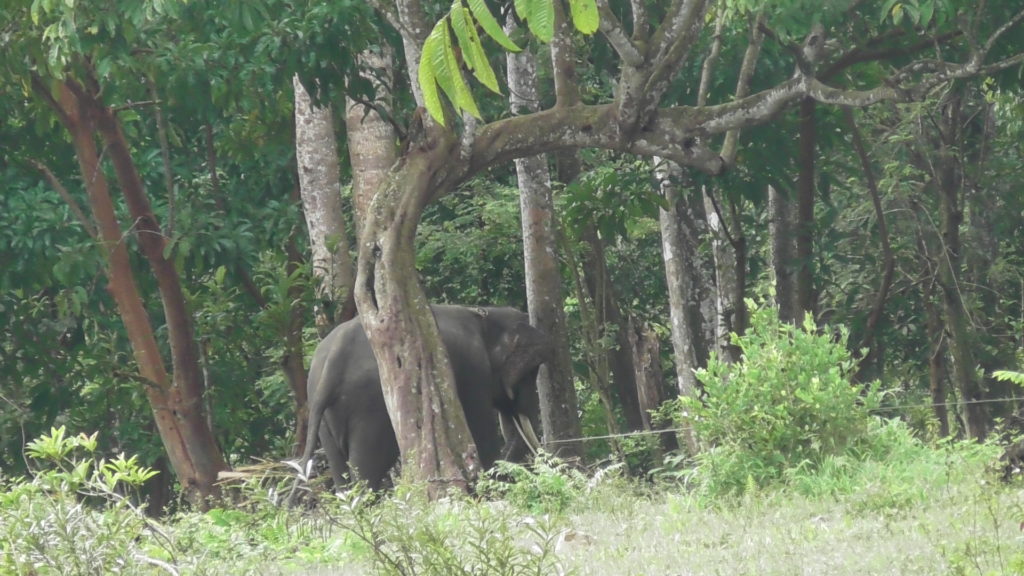
Elephants roaming free
Walking with the Elephants
Because of world condemnation, the CRU has recently launched a new elephant experience – ‘Walking with Elephants’. This is a new tour developed to give alternative options to riding – for tourists who want to be close with elephants in their natural environment without taking part in elephant back riding. It is an experience which is exclusive to CRU which gives visitors the chance to spend time with the mahouts, help wash the elephants in the river and walk alongside them as they explore their natural jungle environment.
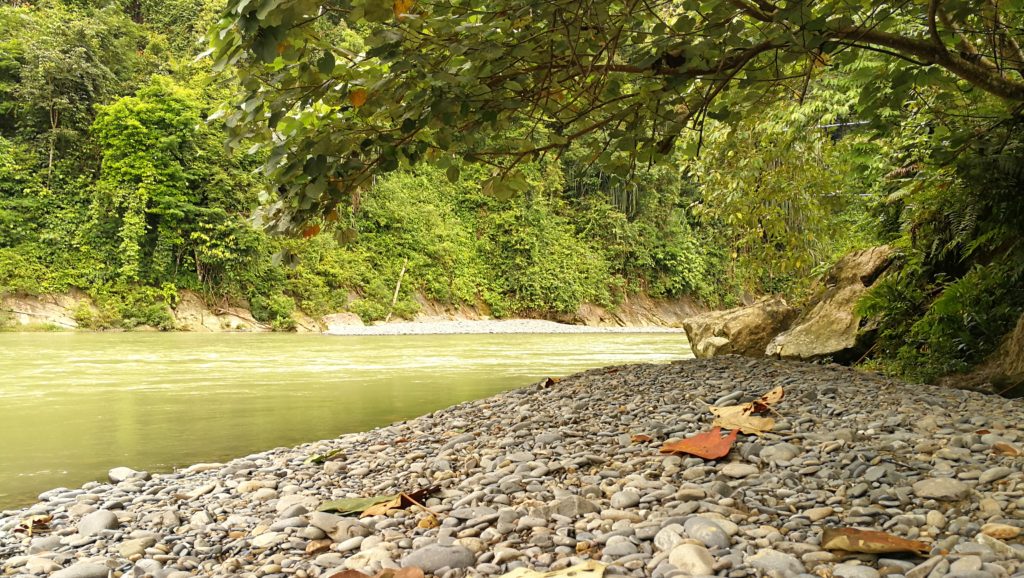
Elephant bathing area
It was so heartening to see the effort that is being made to encourage the locals to embrace this new idea – especially when it is their livelihood on the line. We are confident that they are headed in the right direction with this move but it will take time to fully take the stance of the total banning of elephant riding.
It’s so easy for us to take the moral high ground and put a stake in the ground when it comes to these sorts of activities. When it comes to people’s everyday survival, whether they have food on the table that night, whether children can go to school and be clothed and whether they can keep a roof over their heads – the line between good and bad can get blurred a bit.
River Tubing
The Kualsa Buluh River winds its way along side the remote rural village of Tangkahan. We were not going to pass up on the opportunity to ride an inflated inner tube down this quick flowing river.
Heavy rain a few days prior meant that the river levels were too high when we first arrived but they quickly drop so conditions were ideal.
When is a bridge not a bridge!
It was a great and picturesque half hour hike to get to the starting point on the river. What wasn’t so great however, was the need to walk across this perilous looking cable bridge. It was long, extremely high and with two planks of wood to walk on (some of these were rotted through). Hence kicked in another one of my fears mentioned earlier in the blog…….HEIGHTS!!
Scotty, forever the gentleman went over first to quell my fear of the weight factor. It took all my courage to take that first step. Three jungle boys, Scotty and Carly all descended into silence as they watched me painfully making my way over this ‘death defying’ bridge. Step by painful step.
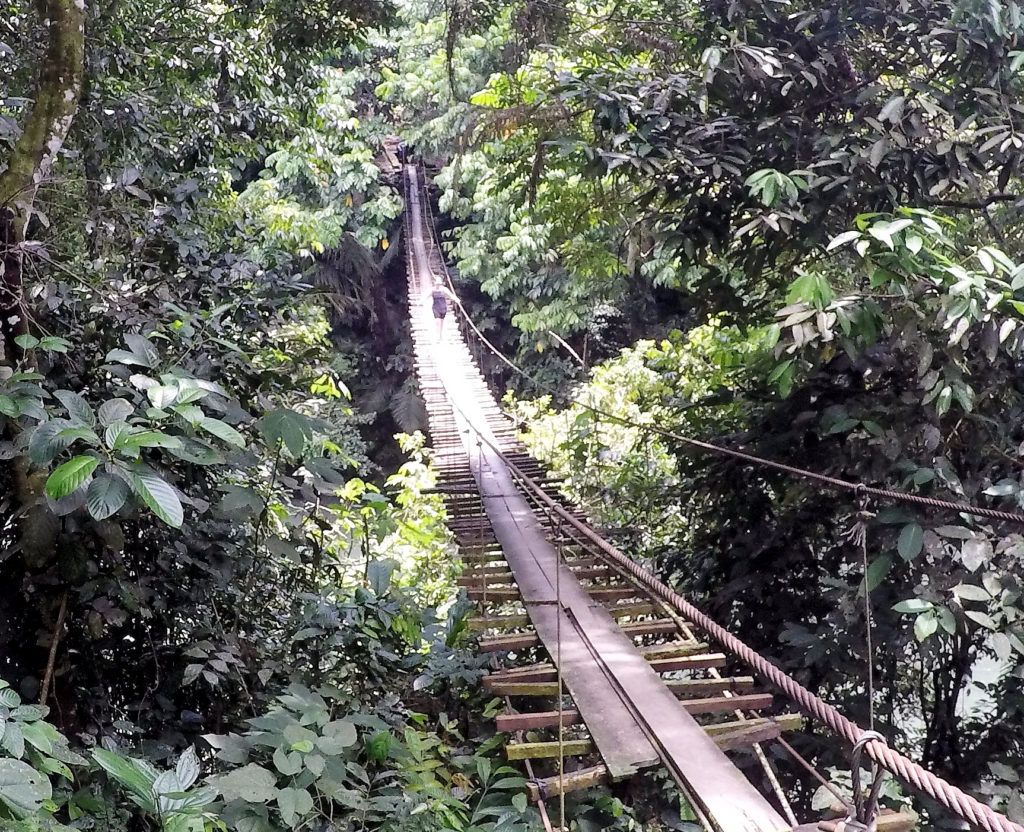
This so doesn’t show the huge height above the raging river below!!
When there is no other choice but to push through such a fear, it really is the only motivator to make yourself do it. I wasn’t about to turn around and forego my tubing experience so I just had to do it. It did take me about an hour for the shaking to subside but at least I rode the wave of adrenaline for the rest of the afternoon.
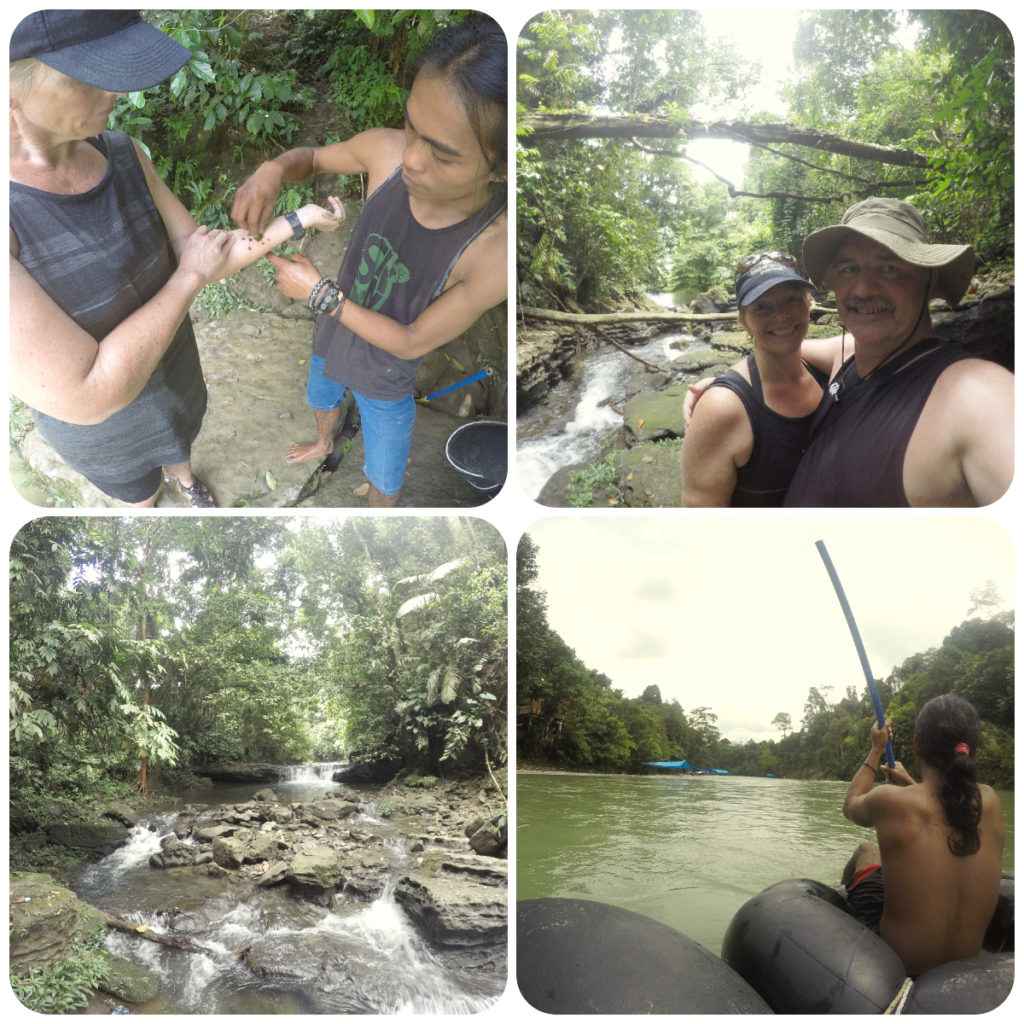
Medical treatment ‘Jungle Style’ for some Fire Ant bites and some special scenery while tubing
With our inner tubes all lashed together it was an amazing 2 hours drifting down the river, calling into the most amazing waterfall on the way. It was truly a surreal experience and one that we will probably not get to experience again.
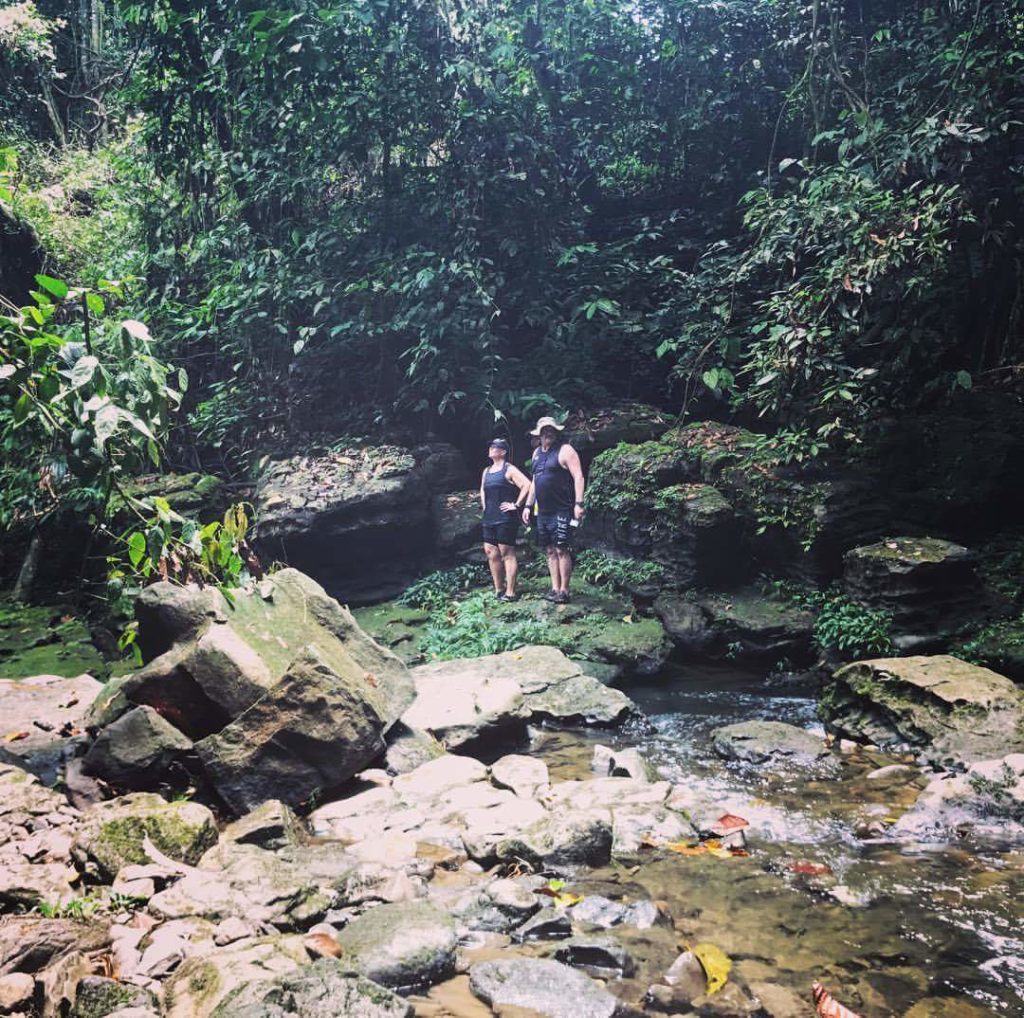
Summary
We extended our stay to 4 nights. It didn’t matter that the toilet didn’t flush, that there was no hot water or shower. The relaxation of being surrounded by such remoteness was unique and one which we embraced.
The people were amazing. They all made us feel so welcome. We enjoyed just sitting around in the common area listening to them singing and strumming away on the guitar. We were serenaded with traditional Karonese music (with Hotel California thrown into the mix). It’s the way life used to be before things got so complicated. Before Facebook and Instagram.
The staff all can speak basic English. We got the opportunity to teach a number of them a few English lessons. I’m not sure if it was helpful but they learnt to say ‘may I take your plate’ in a Kiwi accent!!!
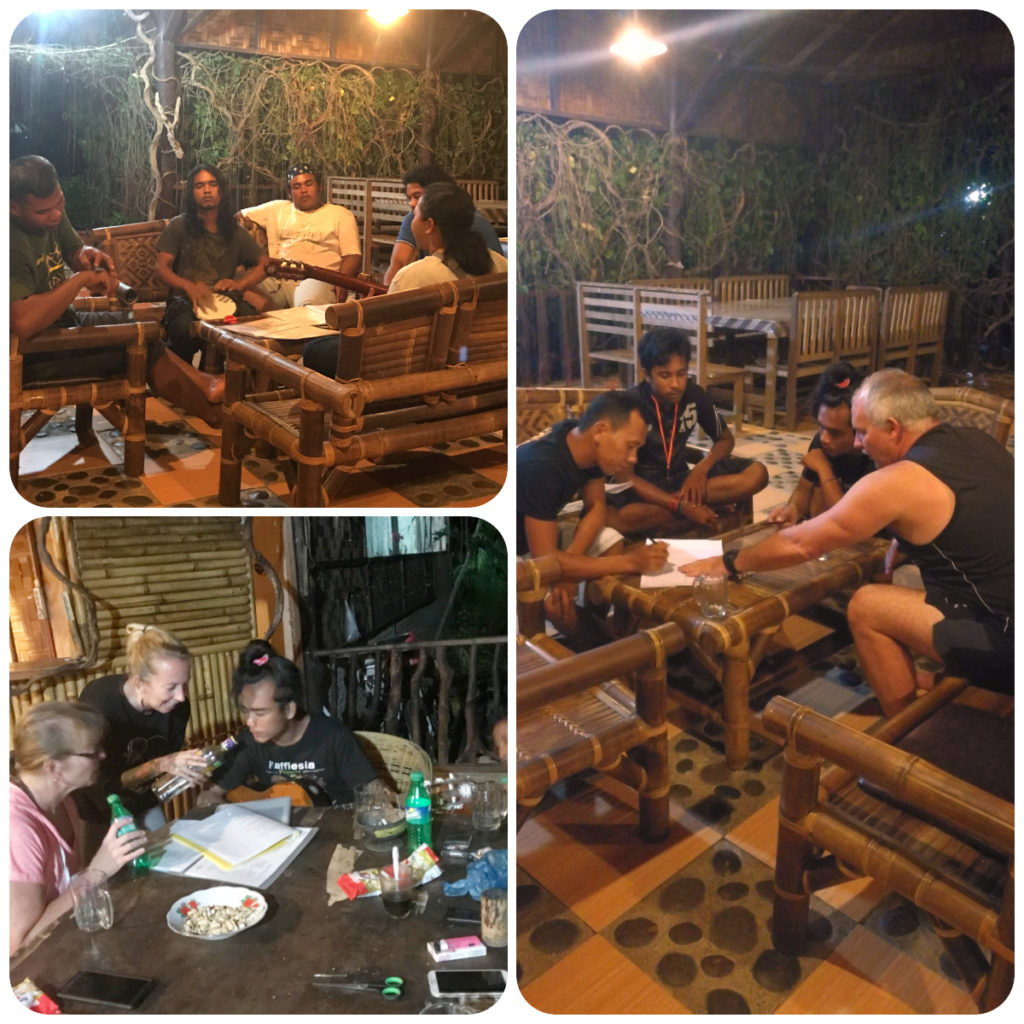
Guitars and singing (when empty bottles become microphones) and Scotty giving English lessons
There was a varied menu available for breakfast, lunch and dinner. Western and Karonese options were on offer. The ingredients were fresh and tasty. I know the chicken was fresh. I witnessed the cook going out with the machete in search of the next chook on death row….. ‘welcome to the jungle’.
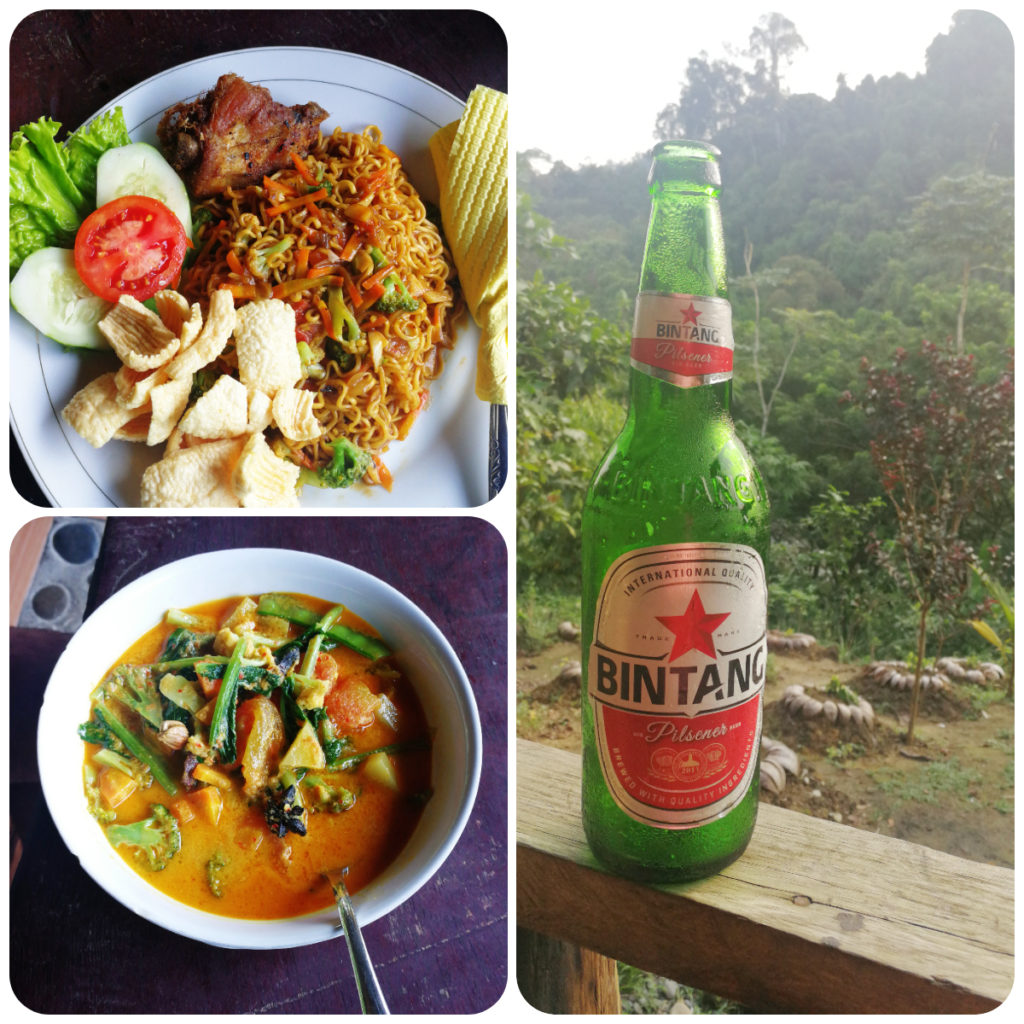
Karonese Food and a cold Bintang – what more do you need
Thanks for having us Carly. We enjoyed sharing a little bit of what life is like living in the remote North Sumatra jungle. Keep up the good work.
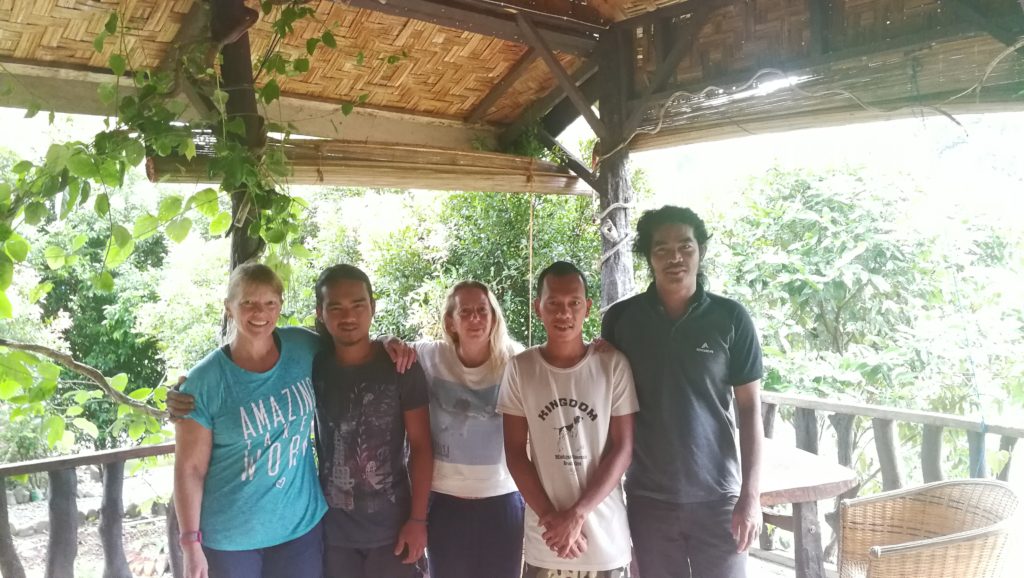
Me, Carly and some of the ‘Jungle Boys’ team
Click on the link below for a video of some of the highlights of our stay.
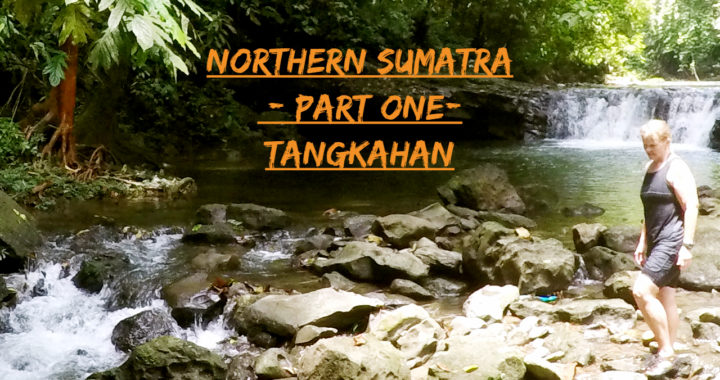
Wow, what an adventure you two are having. I totally understand the fear of heights, I am the same, trying very hard to beat it. I emphasis the trying The rainforest looks amazing and so does the food!
The rainforest looks amazing and so does the food!
It’s a terrible fear to have and only hits me sometimes – it’s weird that I’m okay with some heights and so not okay with others.
Pingback: Blogger to Blogger – The Liebster Award – Global Housesitter x2
Have nominated you Check out the following post https://globehousesitterx2.wordpress.com/2017/11/25/blogger-to-blogger-the-liebster-award/
Check out the following post https://globehousesitterx2.wordpress.com/2017/11/25/blogger-to-blogger-the-liebster-award/